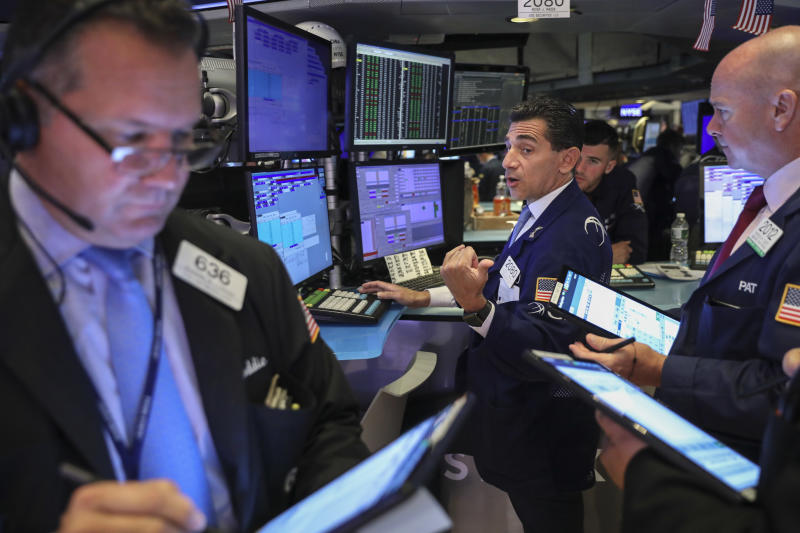Stock market news: August 29, 2019
Domestic stocks climbed Thursday after the latest update in the shifting U.S.-China trade war narrative suggested Beijing would not retaliate against the Trump administration’s most recent set of tariff increases.
Here were the main moves in the market as of 9:39 a.m. ET:
- S&P 500 (^GSPC): +1.11%, or 31.97 points
- Dow (^DJI): +1.13%, or 294.54 points
- Nasdaq (^IXIC): +1.43%, or 112.18 points
- 10-year U.S. Treasury yield (^TNX): +2.8 bps to 1.496%
- 30-year U.S. Treasury yield (^TYX): +3.4 bps to 1.972%
Thursday morning, a spokesman for China’s Ministry of Commerce said China “firmly opposes escalation of the trade war” and was willing to resolve the dispute with “calm” cooperation, according to translations of these public remarks from multiple media reports.
“China has ample means for retaliation, but thinks the question that should be discussed now is about removing the new tariffs to prevent escalation of the trade war,” spokesperson Gao Feng said, according to a Bloomberg translation of the remarks.
Gao added that “effective communications” have remained between the two delegations. He did not, however, confirm whether the two sides would meet in September, as had previously been expected. On Wednesday, U.S. Treasury Secretary Steven Mnuchin told Bloomberg that trade negotiators from the U.S. and China were set to meet in Washington, D.C., but did not specify when the meeting would take place.
The remarks come as more tariffs on Chinese imports are set to take effect Sept. 1, as had previously been announced by President Donald Trump. These levies will be imposed on $300 billion worth of Chinese imports, at a rate that had recently been increased to 15%.
Rapidly shifting updates in the U.S.-China trade war have been a major source of market volatility this month, with investors grabbing hold of any evidence of progress toward a resolution of the more than year-long dispute.

The result has been a month with three separate 2% or more down days in the major U.S. stock indices, and tumbling U.S. Treasury yields as investors flocked to safety.
Some analysts have come out with strategies to try and mitigate the damage to investors’ portfolios as a result of the trade war. Many of these tactics have centered on steering market participants away from companies with high exposure to China, and shifting focus to service-producing firms, which have largely sidestepped some of the weakness evidenced in goods-producing companies as of late.
Other analysts see current conditions as laying the groundwork for a broad-based stock run-up over the next year.
“We believe the increasingly pessimistic sentiment among individual investors, our key tactical indicators, and flight to quality as evidenced in U.S. Treasury yields, sets the stage for the next leg higher toward our 2020 SPX target of 3,350 driven by: (1) “less poor” global economic data; (2) significantly more accommodative monetary policy; and (3) news and tweet fatigue,” Canaccord Genuity analyst Tony Dwyer said in a note to clients Thursday.
“There is no question the trade war is accelerating, but we believe it has largely kept investors on the sidelines over recent weeks, and we believe it is time to react,” he added.
Dwyer’s 2020 price target for the S&P 500 implies 16% upside from Wednesday’s closing level.
2Q GDP revised lower to 2.0%, matching expectations
U.S. economic activity was revised lower for the second quarter, based on the government’s second print on gross domestic product for the period. However, data on the consumer – the primary growth engine of the U.S. economy – was revised even higher than its previous pace.
Second-quarter GDP grew 2.0% at an annualized pace, according to the revision, down from the 2.1% clip reported previously. The read was in-line with consensus economist expectations.
Personal consumption grew 4.7%, up from the 4.3% pace previously reported and marking the highest reading since 2014. Consumption comprises 70% of domestic economic activity. However, this surge in consumer activity was offset in the overall GDP read by lower readings for trade-sensitive data on exports and inventories, as well as softer prints for residential investment and government spending.




Post a Comment